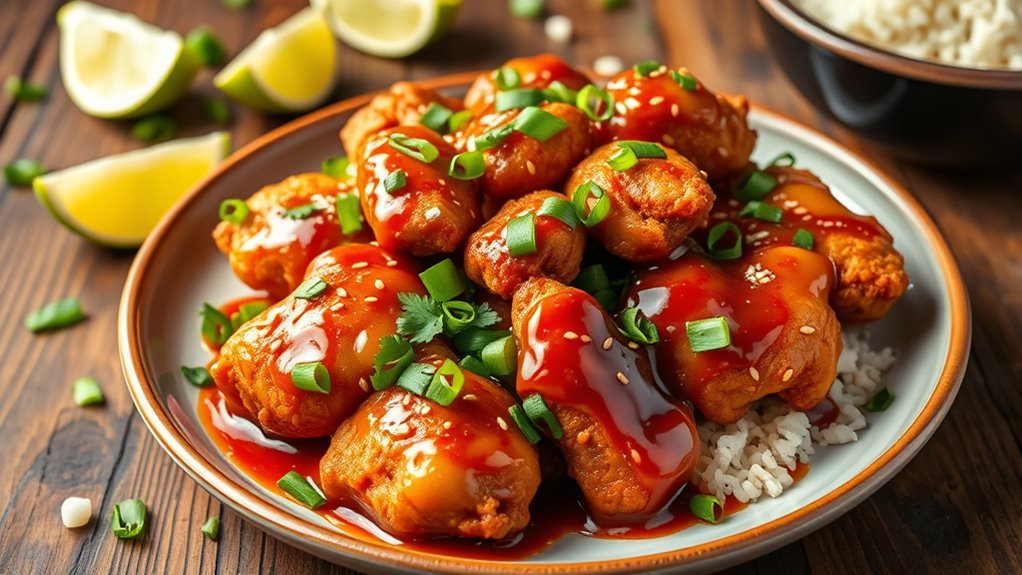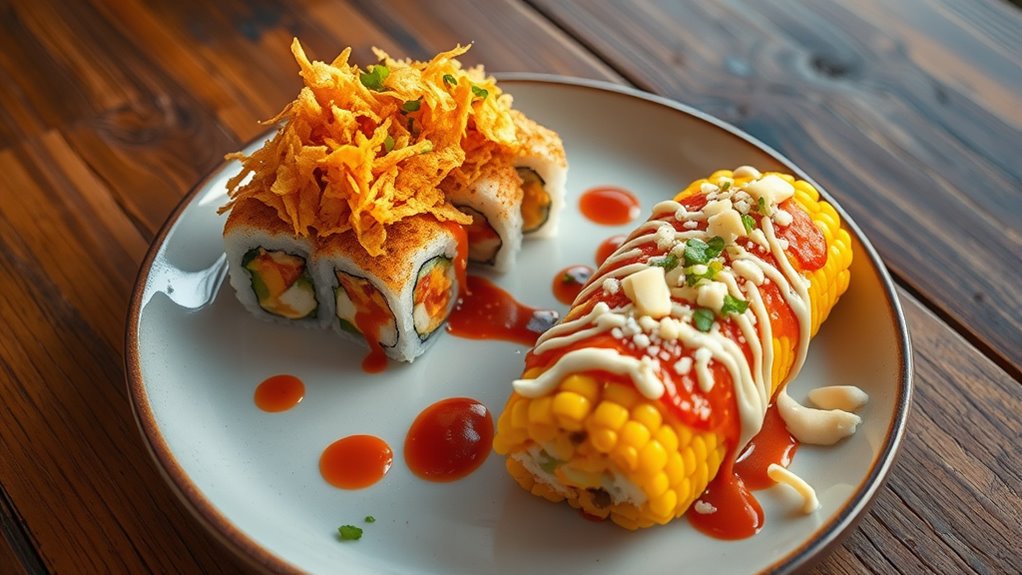Fusion food combines different culinary traditions to create inventive, unexpected flavors that challenge conventional boundaries. You’ll notice how it blends techniques, ingredients, and presentation styles from multiple cultures, resulting in dishes that are both familiar and surprising. This approach celebrates diversity, encourages experimentation, and reflects a history of cultural exchange. If you want to explore more about how these vibrant flavors come together and the stories behind them, keep exploring this exciting culinary world.
Key Takeaways
- Fusion food combines flavors and techniques from multiple cultures to create innovative, culturally rich dishes.
- It challenges culinary boundaries by blending ingredients and methods from diverse traditions.
- Fusion dishes often reflect migration, globalization, and cultural exchange, fostering understanding through taste.
- Chefs rethink traditional recipes and presentation styles to forge harmonious, creative culinary experiences.
- The approach emphasizes experimentation, inviting exploration of new flavor profiles, textures, and visual appeal.

Have you ever wondered what happens when different culinary traditions collide? It’s like a culinary crossroads where flavors, techniques, and ingredients from diverse cultures come together to create something new and exciting. Fusion food isn’t just about mixing two dishes; it’s about blending the essence of different cuisines to craft innovative meals that surprise and delight your palate.
Fusion cuisine merges diverse flavors and techniques, creating innovative dishes that surprise and celebrate cultural exchange.
When chefs experiment with these combinations, they often challenge your expectations, pushing boundaries to develop unique dishes that tell a story of cultural exchange.
Imagine biting into a taco filled with Korean barbecue ingredients or savoring sushi topped with spicy mango salsa. These creations aren’t accidental—they’re deliberate efforts to bridge culinary worlds.
By combining elements from multiple traditions, chefs harness the best of each, resulting in dishes that are both familiar and novel. This fusion approach often involves rethinking traditional recipes, adapting techniques, and using ingredients that mightn’t typically be paired together.
It’s about taking risks and celebrating diversity on a plate.
At its core, fusion food encourages creativity and innovation. You’re invited to explore new flavor profiles, textures, and presentation styles that break away from conventional boundaries.
For example, a classic Italian pasta dish might be infused with Thai spices or served alongside a Caribbean-inspired seafood salad. These combinations may seem unconventional, but they work because they respect the integrity of each cuisine while forging a harmonious new experience.
It’s like a culinary dialogue that respects the roots but isn’t afraid to cross borders.
You might also notice that fusion food often reflects a broader cultural narrative—stories of migration, globalization, and the blending of communities.
When you taste a dish that’s a fusion, you’re experiencing more than just flavors; you’re engaging with a history of cultural exchange.
Chefs often draw inspiration from their own backgrounds or global trends, creating dishes that resonate on multiple levels.
Additionally, understanding the principles of culinary innovation can help chefs craft more successful fusion dishes by thoughtfully combining techniques and ingredients.
This approach not only celebrates diversity but also fosters understanding and appreciation for different traditions.
Ultimately, fusion food is about curiosity and exploration. It invites you to be adventurous, to try something unfamiliar, and to enjoy the process of discovery.
Whether it’s a simple twist on a classic or a bold, innovative creation, fusion food challenges you to expand your culinary horizons.
It’s a testament to the creativity of chefs and the endless possibilities when cultures collide.
Frequently Asked Questions
How Does Fusion Food Influence Local Culinary Identity?
You might wonder how fusion food impacts local culinary identity. It often introduces new flavors and techniques that can enrich traditional dishes, making them more innovative and appealing.
However, it can also challenge cultural authenticity if it overpowers traditional recipes. As a result, fusion food can either celebrate diversity and creativity or risk diluting unique culinary heritage, depending on how it’s embraced and integrated into local food scenes.
What Are the Most Popular Fusion Dishes Worldwide?
Imagine a world where flavors collide—you’re curious about the most popular fusion dishes worldwide. Dishes like Korean tacos, sushi burritos, and Thai pizza top the charts, blending ingredients and techniques from diverse cultures. These dishes capture your palate’s attention, showcasing culinary creativity.
They’re beloved because they offer familiar comfort with an exciting twist, inviting you to explore global flavors in every bite. Fusion dishes turn eating into a vibrant, cultural adventure.
How Do Chefs Balance Authenticity With Innovation?
You want to know how chefs balance authenticity with innovation. They start by respecting traditional flavors and techniques, ensuring the core essence remains intact.
Then, they get creative by adding new ingredients or presentation styles that surprise and delight. You should focus on harmony, making sure the innovative elements complement rather than overpower the authentic aspects.
This way, you create dishes that honor tradition while exciting the modern palate.
Are There Health Concerns With Fusion Cuisine?
Imagine you’re a chef in the 21st century, and you’re wondering if fusion cuisine has health risks. While it’s generally safe, mixing ingredients from different cultures can sometimes lead to allergies or high sodium and fat levels if not carefully balanced.
You should focus on using fresh, whole ingredients and mindful portion sizes. Just like a well-crafted app, fusion dishes need thoughtful planning to keep them both delicious and healthy.
What Are Future Trends in Fusion Food Development?
You’re curious about the future trends in fusion food development. Expect more innovative combinations driven by global influences, sustainability, and health-conscious choices.
Chefs will experiment with plant-based ingredients, local flavors, and eco-friendly techniques.
Expect to see personalized fusion dishes tailored to dietary needs, incorporating technology for customization.
As culinary boundaries expand, fusion cuisine will become more diverse, exciting, and reflective of a connected, environmentally aware world.
Conclusion
So, next time you try a sushi burrito or a kimchi quesadilla, remember you’re celebrating more than just flavors. You’re celebrating creativity, culture, and connection. You’re breaking boundaries and building bridges. You’re blending traditions and embracing new tastes. Fusion food isn’t just about mixing ingredients; it’s about mixing stories, memories, and dreams. So, keep exploring, keep tasting, and keep celebrating the beautiful diversity that makes every meal an adventure.









